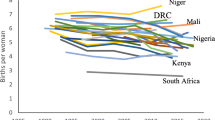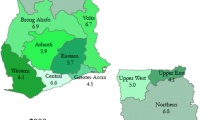Abstract
This paper explores answers to the following two questions: first, did individuals' socioeconomic characteristics play any role in the rapid fertility decline that occurred in China during the 1970's? Secondly, if the rapid fertility decline during the 1970s is mostly a result of the government policy, as many have perceived, to what extent was the government policy effective? Using the 1982 Chinese 1/1000 fertility survey data for Hebei province of China, this paper examines variation in fertility among women of two age cohorts by linking their fertility outcome with their socioeconomic background and earlier reproductive experiences. In addition, this paper assesses the effect of government policy by comparing the determinants of fertility outcome between two cohorts of women and by studying the factors affecting their current contraceptive use. The findings reveal that the individual's socioeconomic background was important in explaining earlier fertility variation. Government policy, although powerful enough to override most of the effect of socioeconomic factors on fertility, was not able to eliminate differences in contraceptive behavior among Chinese women.
Similar content being viewed by others
References
Arnold, Fred and Zhaoxiang Liu (1986). ‘Sex preference for children in China’,Population and Development Review 12: 221–246.
Birdsall, Nancy and D. Jamison (1983). ‘Income and other factors influencing fertility in China’,Population and Development Review 9:651–675.
Bongaarts, John (1983). ‘The fertility-inhibiting effects of the intermediate fertility variables’,Studies in Family Planning 13: 179–189.
Bongaarts, John and Susan Greenhalgh (1985). ‘An alternative to the one-child policy in China’,Population and Development Review 11: 585–618.
Boulier, Bryan and Mark Rosenzweig (1978). ‘Age, biological factors, and socioeconomic determinants of fertility: A new measure of cumulative fertility for use in the socioeconomic analysis of family size’,Demography 15: 487–498.
Bulatao, Rodolfo A. and Ronald D. Lee (ed), (1983).Determinants of Fertility in Developing Countries: A Summary of Knowledge, New York: Academic Press.
Chen, Pi-Chao and Adrienne Kols (1982). ‘Population and birth planning in the People's Republic of China’,Population Reports. Series J. No. 25.
China's Statistics Press (1985).Hebei Economic Statistics Yearbook 1985. Beijing.
Coale, Ansley J. (1984).Rapid Population Change in China 1952–1982. Committee on Population and Demography, Report no. 27. Washington, D.C.: National Academy Press.
Coale, Ansley and Shengli Chen (1987)Basic Data on Fertility in the Provinces of China, 1940–82. Paper of the East-West Population Institute. No. 104. East-West Center. Honolulu.
Cochrane, Susan H. (1983). ‘Effects of education and urbanization on fertility’, in R. Bulatao and R.D. Lee (ed.),Determinants of Fertility in Developing Countries: A Summary of Knowledge. New York: Academic Press.
Croll, Elisabeth J. (1984). ‘The single-child family: The first five years.’ in Maxwell, Neville and McFarlan Bruce (ed.),China's Changed Road to Development. Oxford: Pergamon Press.
Entwistle, Barbara, Albert Hermalin, and William M. Mason, (1982).Socioeconomic Determinants of Fertility in Developing Nations, Theory and Initial Results. Report No. 17. Washington, D.C.: National Academy of Sciences Press.
Freedman, Ronald, Zhenyu Xiao, Bohua Li, and William Lavely (1988). ‘Local area variation in reproductive behavior in the People's Republic of China, 1973–1982’,Population Studies 42: 39–57.
Greenhalgh, Susan (1986). ‘Shifts in China's population policy’,Population and Development Review 12: 491–515.
Kaufman, Joan (1983).A Billion And Counting: Family Planning Campaigns and Policies in the People's Republic of China. San Francisco: San Francisco Press.
Parish, William L. and Martin K. Whyte (1978).Village and Family in Contemporary China. Chicago: The University of Chicago Press.
Poston, Dudley and Baochang Gu (1987). ‘Socioeconomic development, family planning and fertility in China’,Demography 24: 531–551.
Rodriguez, G. and John Cleland (1980). ‘Determinants of marital fertility in twenty countries: A multivariate analysis’, World Fertility Survey conference, Substantive Findings Sessions, No. 5. London.
Tien, H. Yuan (1984). ‘Induced ferility transition: Impact of population planning and socioeconomic changes in the People's Republic of China’,Population Studies 38: 385–400.
Whyte, Martin K. (1983). ‘Town and country in contemporary China’,Transaction Periodical Consortium. Vol. X, No. 1.
Whyte, Martin K. and S.Z. Gu (1987). ‘Popular response to China's fertility transition’,Population and Development Review 13: 471–492.
Whyte, Martin K. and William L. Parish (1984).Urban Life in Contemporary China. Chicago: The University of Chicago Press.
Wolf, Arthur (1986). ‘The preeminent role of government intervention in China's family revolution’,Population and Development Review 12: 101–116.
World Bank (1984).World Development Report 1984. New York: Oxford University Press.
Zhao, Weigang (1986). ‘Level and trends of fertility in Hebei provine 1964–1982’, inLevels and Trends of Fertility in Jilin and Hebei Province, China. Asian Population Studies Series, No. 62-9. Bangkok: Economic and Social Commission For Asia and the Pacific.
Author information
Authors and Affiliations
Rights and permissions
About this article
Cite this article
Wang, F. The roles of individuals' socioeconomic characteristics and the government family planning program in China's fertility decline. Popul Res Policy Rev 7, 255–276 (1988). https://doi.org/10.1007/BF02456105
Issue Date:
DOI: https://doi.org/10.1007/BF02456105




